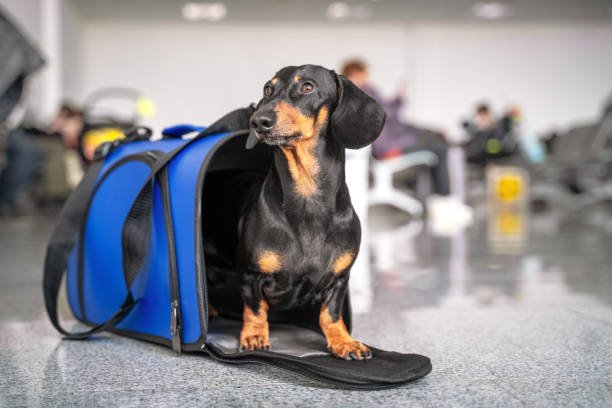International Dog Travel Tips.
Being able to take your dog on vacation with you is one of the most rewarding aspects of owning a dog, but it can also be one of the most difficult aspects.
This may be particularly true if you are going to be traveling abroad since there are certain procedures and regulations that must be followed in order to take a dog out of the country in which they were born.
The good news is that there are a lot of hints and suggestions that can help make your journey to another country go more easily, and if you prepare ahead of time, they will even make it safer and more fun for you.
Regulations for the International Transport of Pets
Researching the international pet travel restrictions of each country to which you want to take your dog is something you should do before leaving on your trip.
Before you make an effort to travel to another country with your dog, you should make sure you have a thorough understanding of the applicable rules and regulations, since these aspects differ from nation to nation.
It is also a good idea to be ready for any changes in policy that may take place between now and the time that you go, since this is a good practice.
A blood test, microchip, health certificate, or vaccine against rabies may be necessary to get entry into some countries.
Depending on where you are going on your trip, you may be required to get more vaccines in addition to providing documentation that you had them after they were provided. You will need to collect these records from your animal care professional.
In general, the following are things that are necessary in every country:
- The following is a list of restrictions about traveling internationally with pets:
- Every animal is required to have a microchip inserted.
- Every animal must be in good physical condition, get enough nutrition, and be up to date on all vaccines (including rabies)
- To be allowed to travel overseas, pets need to be at least 8 weeks old. (They are also required to have a health certificate that has been granted in order to travel to or from Hawaii.)
- Before leaving the United States, you must have had ownership of your pets for at least 48 hours, and this time period includes any time your pets spent in quarantine at a facility that was authorized by the government.
Your pet’s carrier has to be roomy enough for your pet to easily stand up, turn around, and lay down, and the carrier also needs to have sufficient ventilation for your pet’s safety.
Certificate of Immunizations and Physical Examination
You will be responsible for ensuring that your dog is up to date on all of its vaccines, including those for rabies and distemper. Before going on a trip with your dog, you should check to see whether it is up to date on its rabies vaccine. If it is not, you may be compelled by law to get it done.
A health certificate is another necessity for foreign travel with dogs. The certificate has to demonstrate that your canine companion is in pristine physical condition, devoid of any communicable illnesses, and healthy overall.
It is recommended that you make an appointment for a checkup for your pet before going overseas with them, just in case there are any problems that you haven’t been aware of up to this point.
Make sure you ask your airline about this.
Checking in with your airline is the next thing you’ll want to do before moving on to the next activity. Make sure that your airline permits dogs and that they have an open policy about having them on board.
There are certain airlines that
do not allow pets, so make sure that your airline does.
When it is finally time to leave the country and go back home, you should check in with the customs and immigration officials at the airport, the city, and the country where you will be returning to.
In order to travel lawfully with pets, citizens of some nations are required to provide certain documentation or permissions, whereas citizens of other nations are not required to present any documentation at all.
The Carrier for Your Dog a little Pomeranian or Spitz enclosed in a travel suitcase and carried into an airplane
Make sure your dog is comfortable being transported in the carrier before you go. It is important that your dog be acquainted with the carrier before you attempt to transport them to an unknown area in it; otherwise, they may get anxious and try to escape.
When you are placing your dog into their carrier, it is in everyone’s best interest for them to be on a leash so that you can swiftly get control of them if required.
Obtain a Microchip for Your Dog.
It is essential that your pet be implanted with a microchip before you go on a trip with it.
A microchip is a very small electronic device that may carry a one-of-a-kind identification number and is implanted beneath the skin. In the event that your dog wanders off or goes missing, the number may be used to locate and identify them.
A syringe is used to inject a microchip into the region around your dog’s shoulder using a microchip that is roughly the size of a grain of rice. There are often no adverse effects, and the amount of time needed for recuperation is typically rather short.
The chips are often hidden in a location that is inaccessible to the naked eye, such as between the scapulae (shoulder blades).
However, if you want to know where the chip is situated, you should ask your veterinarian as they are implanting it into the body of your pet. Make sure that your dog has been microchipped before you leave for their destination if you have plans to take them on an overseas trip.
Upon arriving back in the United States
It is possible that you may be asked to provide evidence that your dog complies with the import rules of the United States when you return to the nation from another country. In addition, prior to boarding your aircraft, you may be required to pay certain fees and collect certain documentation.
The Animal and Plant Health Inspection Service, or APHIS, is responsible for enforcing the rules and regulations that govern the introduction of canines and felines into the United States.
In order to enter the United States with your dog, you are required to provide a rabies vaccination certificate that is still current for at least one month after the day on which you enter the country.
The immunization must be given by a veterinarian who is licensed to practice, and it must contain the following information:
- The name of the canine patient who is undergoing vaccination.
- The name, address, and telephone number of the proprietor
- The canine’s date of birth or its current age
- The kind of vaccination that was administered (rabies)
- If it is available, the serial number or the lot number from the manufacturer’s label that is located on the vaccination container.
This information is not necessary, but providing it might make the inspection process at the ports of entry go more smoothly.
It is the responsibility of the United States Department of Agriculture, sometimes known as the USDA, to issue passports to pets that are either entering or exiting the nation. In order to enter or exit the nation with a dog, a USDA form 7001-9 has to be filled out and submitted.
Put everything into one place.
It is possible to make traveling with your dog a breeze so long as you prepare in advance, check that your dog is in good condition and has had all of the necessary vaccines, and pack the appropriate documentation and carrier. Take into account the temperament and comfort level of your dog.
If you have an older pet that has never been in a carrier before or is uncomfortable with them in general, you should spend some time before your departure date to train them so that they become acclimated to it. This will help them feel more at ease when you actually put them in the carrier.
When traveling with your pet, be sure to take the necessary measures. Depending on the size and weight requirements of the airline, cats and dogs are required to travel in separate carriers; therefore, it is important to verify these requirements before booking flights.
In addition, it is typical for airlines to require certain vaccinations for pets that will be traveling internationally. Before booking flights departing from the United States, it is important to conduct research online to learn more about the requirements imposed by individual airlines.
Some countries require that pets traveling from other countries have documentation proving that they have been vaccinated against rabies. Ensure that this information is recorded on any documentation that is provided by the local authorities at the point of entrance into a foreign country.
Don’t Let Your Anxiety Ruin Your Trip!
The vast majority of individuals want to take their dogs on vacation with them, but many are hesitant to do so out of concern about the strain that traveling would impose on their pets.
There are a number of things you can do to make the experience of traveling with your dog as stress-free and pleasant as is humanly feasible.
Spend some time reading up on the rules governing the transportation of pets across foreign borders, and double-check that everything is in order before you set off for your trip. If you prepare for your trip with your dog in advance by doing these things, you won’t have any trouble taking him with you.
4 Powerful Methods To Get Urine Smell Out Of Puppy Fur
Symptoms And Allergies From Dog Food
How To Determine A Puppy’s Full Growth





